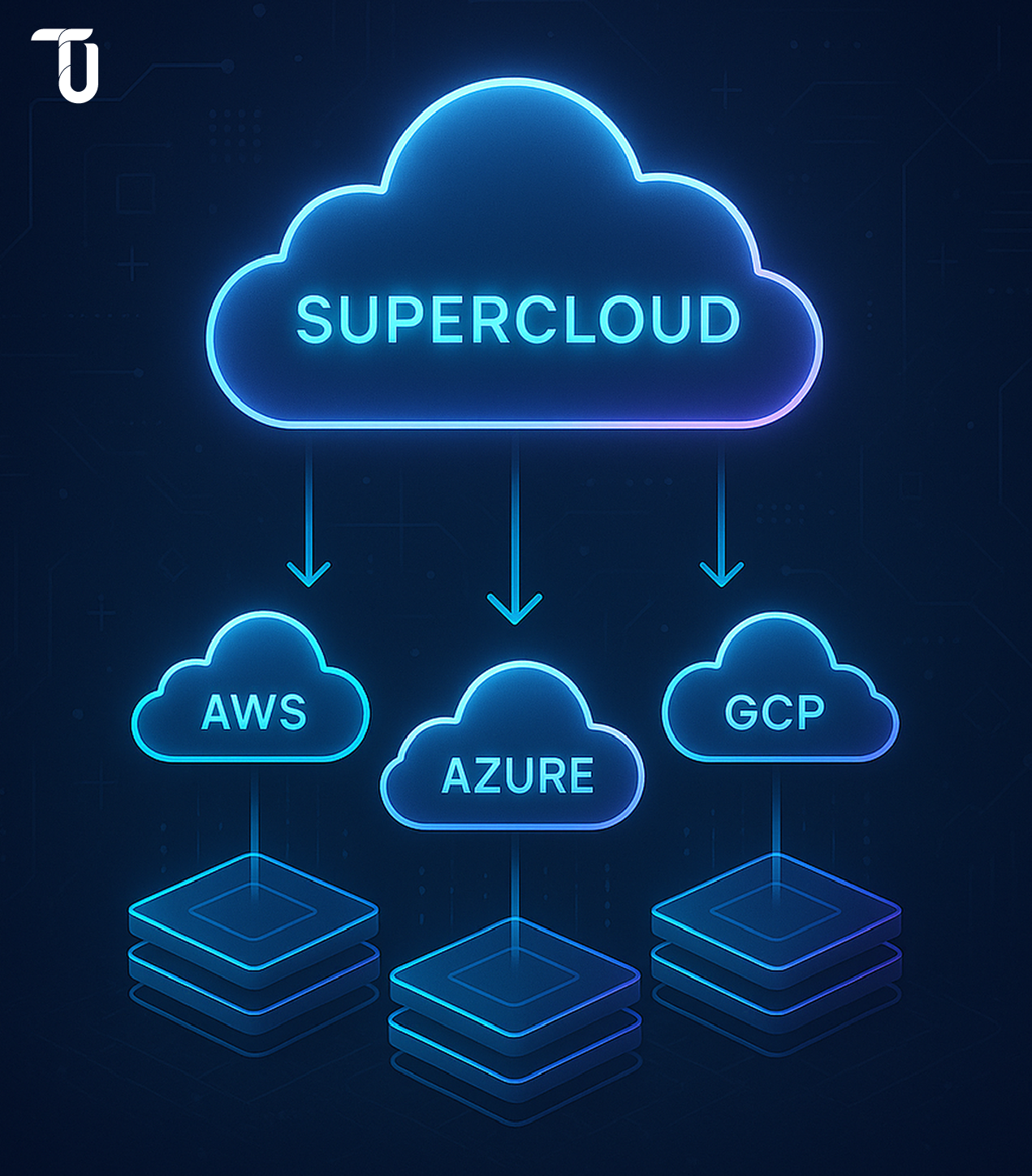What Is Supercloud Architecture: Its Key Layers
Supercloud architecture is a new approach that connects multiple cloud platforms through one common layer. It brings together cloud integration, making it easier to manage public, private, and hybrid clouds in one place. This setup allows cloud orchestration across providers without needing to change each system separately. The Supercloud architecture is made up of several important layers, each with a specific role in managing and connecting different cloud environments. These layers work together to create a flexible, scalable, and secure cloud architecture. Let’s take a closer look at each one.
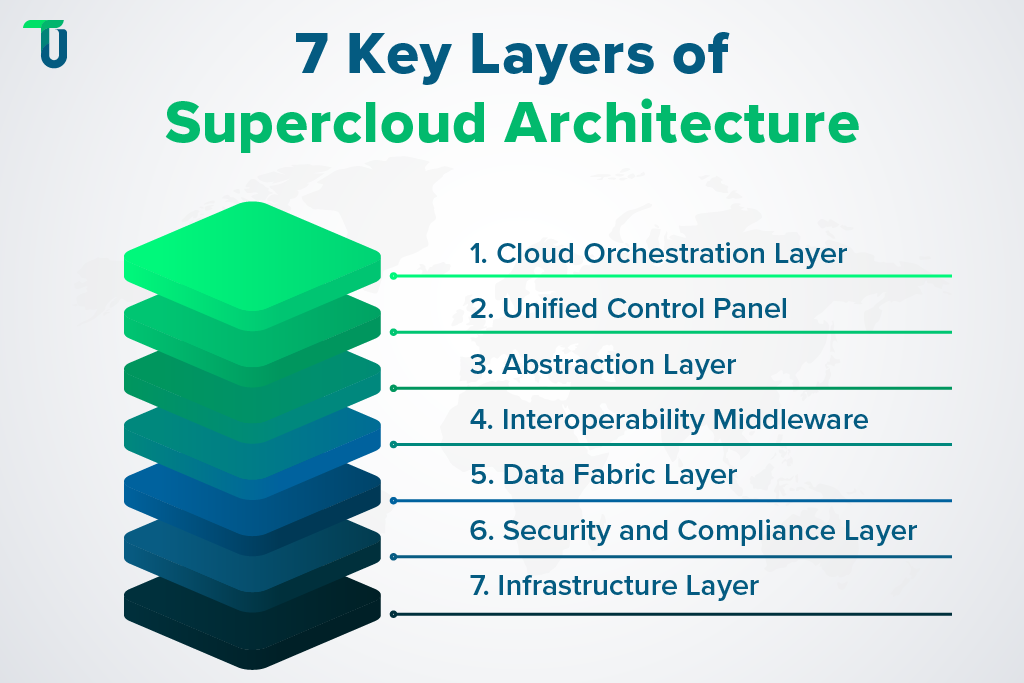
1. Cloud orchestration layer
This layer controls how workloads run across public, private, and hybrid clouds. It helps automate resource allocation, service deployment, and performance management. With the cloud orchestration layer, teams get faster operations, better cost control, and smooth multi-cloud coordination.
2. Unified control plane
This layer brings everything together under one management view. It lets users apply policies, set access rules, and track usage from a single place. The unified control plane improves visibility and gives teams a consistent experience across the full Supercloud architecture.
3. Abstraction layer
The abstraction layer hides the differences between cloud providers. It allows developers to write applications once and run them anywhere. It also powers the AI Supercloud by connecting machine learning tools with shared cloud resources through common APIs and uniform infrastructure.
4. Interoperability middleware
This layer connects services across clouds by translating interfaces and making systems compatible. It helps solve the problem of mismatched tools. With proper cloud integration at this layer, workloads can move between platforms without delay or the need for code changes.
5. Data fabric layer
This layer acts as the data fabric for the cloud, controlling how data is stored, moved, and accessed in real time. It keeps data consistent across clouds and supports high availability. The data fabric allows teams to use analytics, reporting, and backups without worrying about where the data lives — an approach that can also power personalized retirement portfolio management by ensuring real-time, consistent financial data across accounts.
6. Security and compliance layer
Security tools in this layer apply common rules across all clouds. It manages encryption, access control, and auditing. This layer supports zero-trust strategies and makes sure all workloads meet internal and industry standards, even when spread across global environments.
7. Infrastructure layer
This layer includes virtual machines, storage systems, and networks that support cloud scalability. It runs across multiple clouds and edge locations. The infrastructure layer ensures that apps always get the right resources, no matter how much the demand changes.
As we can see, Supercloud architecture brings all critical cloud layers together to offer better control, flexibility, and scalability across platforms, making cloud operations smarter and more unified.
Make Your Multi-Cloud Setup Easier
Struggling with scattered cloud services? Let us help you unify everything into one system for greater control, lower costs, and smoother operations.
Supercloud vs Traditional Cloud Architecture
Before we understand the benefits of Supercloud, let us first compare it with traditional cloud architecture. While traditional models rely on a single provider, Supercloud architecture operates across multiple platforms with a unified approach to cloud orchestration, cloud scalability, and cloud integration.
| Feature | Traditional Cloud Architecture | Supercloud Architecture |
|---|---|---|
| Control | Managed separately for each provider | Centralized through cross-cloud orchestration, allowing seamless coordination between multiple cloud platforms |
| Portability | Low, requires manual configuration | High, supports workload movement without rework |
| Scalability | Limited to one cloud's resources | Cloud scalability across providers and regions |
| Integration | Complex and fragmented | Seamless cloud integration with standard APIs |
| AI Readiness | Not optimized for AI workloads | AI Supercloud supports cross-cloud AI tools and models |
All in all, Supercloud architecture solves many of the pain points in traditional cloud setups. It improves control, enhances portability, and prepares systems for complex, modern workloads.
Expert Advice: When building a Supercloud, make sure to plan for easy compatibility right from the beginning. Using cloud-friendly tools like Kubernetes and Terraform helps your systems connect more easily, scale better, and stay flexible as you work with different cloud providers.
Benefits of Adopting Supercloud Architecture
Supercloud architecture helps businesses manage multiple cloud services from one place. It brings better control, flexibility, and performance to modern cloud environments. Here are its main benefits.
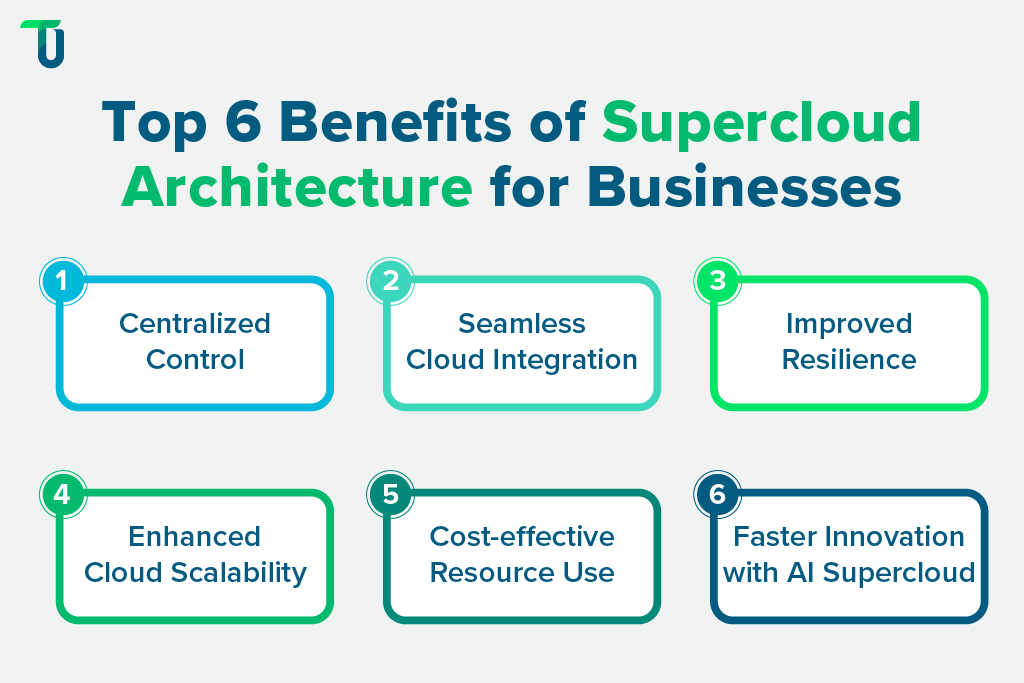
1. Centralized Control
Supercloud architecture creates a unified control layer across AWS, Azure, and other providers, enabling centralized cloud control that simplifies orchestration, strengthens security policies, and improves visibility. This makes cloud architecture easier to manage and reduces time spent switching between platforms.
2. Seamless Cloud Integration
Supercloud enables smooth cloud integration through an abstraction layer. It connects services from multiple vendors without manual setup. This means data and workloads can move across clouds while keeping systems consistent, flexible, and easier to manage across your full stack.
3. Improved Resilience
With Supercloud architecture, workloads run across multiple providers. This setup protects apps from downtime if one provider fails. It increases system reliability and ensures critical services stay active. The result is better performance and less risk of losing access during outages.
4. Enhanced Cloud Scalability
Supercloud architecture enables dynamic cloud scalability across providers, ensuring smooth performance even during high-demand periods. With smart cloud orchestration and the right setup, such as a well-planned scalable cloud application architecture, resources are adjusted automatically based on actual usage. This not only maintains operational stability but also prevents unnecessary spending on underused infrastructure.
5. Cost-effective Resource Use
Supercloud architecture selects the best cloud service for each task. It shifts workloads to cheaper or more efficient providers. It balances cost and performance, avoids overprovisioning, and lowers cloud spending without sacrificing productivity or application speed, especially when paired with strong cloud cost monitoring metrics.
6. Faster Innovation with AI Supercloud
AI Supercloud setups run machine learning and large models across clouds. This increases computing power and speeds up innovation. It lets teams handle demanding AI tasks and scale them easily, thanks to a scalable AI infrastructure that runs across providers.
To encapsulate, adopting Supercloud architecture brings better control, seamless cloud integration, smart cost savings, and stronger AI capabilities.
Related Read:
Supercloud vs Multi‑Cloud vs Hybrid Cloud
Supercloud: A Paradigm Shift in Cloud Computing
Challenges in Building a Supercloud Architecture
Supercloud architecture offers flexibility, but it also comes with challenges. From cloud integration issues to security gaps, here are 6 problems you might face and how to solve them.
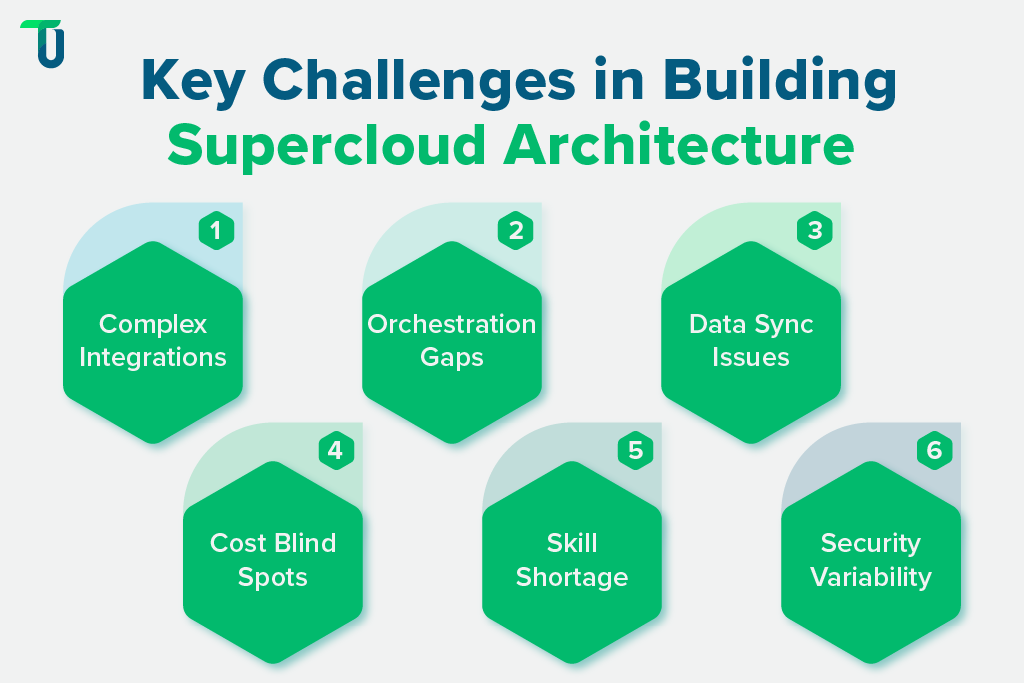
Challenge #1: Complexity of cloud integration across multiple platforms
Each cloud provider has unique APIs, formats, and tools, making cloud platform interoperability a challenge and integration a slow, complex task. To solve this, use a shared cloud integration layer that supports all platforms. It helps reduce custom setup, improves compatibility, and keeps systems in sync.
Challenge #2: Inconsistent orchestration across cloud environments
Cloud orchestration tools behave differently on AWS, Azure, and GCP, leading to misaligned workflows. To fix this, use orchestration platforms designed for multi-cloud support. Standardize workflows to ensure reliable deployment, scaling, and monitoring across all environments.
Challenge #3: Data flow and consistency issues across cloud systems
Data syncing across clouds often fails due to latency, duplication, or outdated versions. To solve this, build a cloud architecture with a shared data fabric that ensures real-time syncing, handles conflict resolution, and protects data integrity across regions.
Challenge #4: Limited cost visibility and poor control over spending
Without a single view, costs across platforms get confusing and unpredictable. To fix this, set up cloud cost optimization tools, such as dashboards and alerts. Automate reports and budget controls to track resource use, reduce waste, and keep cloud scalability efficient and affordable - starting with the right cloud cost monitoring metrics.
Challenge #5: Skill shortages in managing Supercloud infrastructure
Supercloud architecture needs teams skilled in cloud orchestration, security, and integration. To solve this, invest in training and certifications, and refer to a guide to evaluating cloud application development services to select the right partners who can bridge skill gaps.
Challenge #6: Security and compliance gaps across cloud providers
Security rules often vary between providers, creating policy holes and audit risks. To fix this, enforce unified access controls, use encryption everywhere, and apply monitoring tools that support compliance across your entire cloud architecture environment.
To sum up, building Supercloud architecture is complex, but manageable. By solving these challenges with clear planning and the right tools, you can create a secure, flexible cloud architecture that scales.
Pro Tip: Start your Supercloud journey with a small pilot project. First, try out things like orchestration, integration, and security on a limited scale. This helps you lower risks, launch more smoothly, and get your team’s support before expanding across your full multi-cloud setup.
Best Practices for Setting Up Supercloud Architecture
Using Supercloud architecture brings real advantages, but success in setting it up requires clear best practices. Here are 6 steps to guide your teams through planning, setup, and operations in a simple yet effective way.
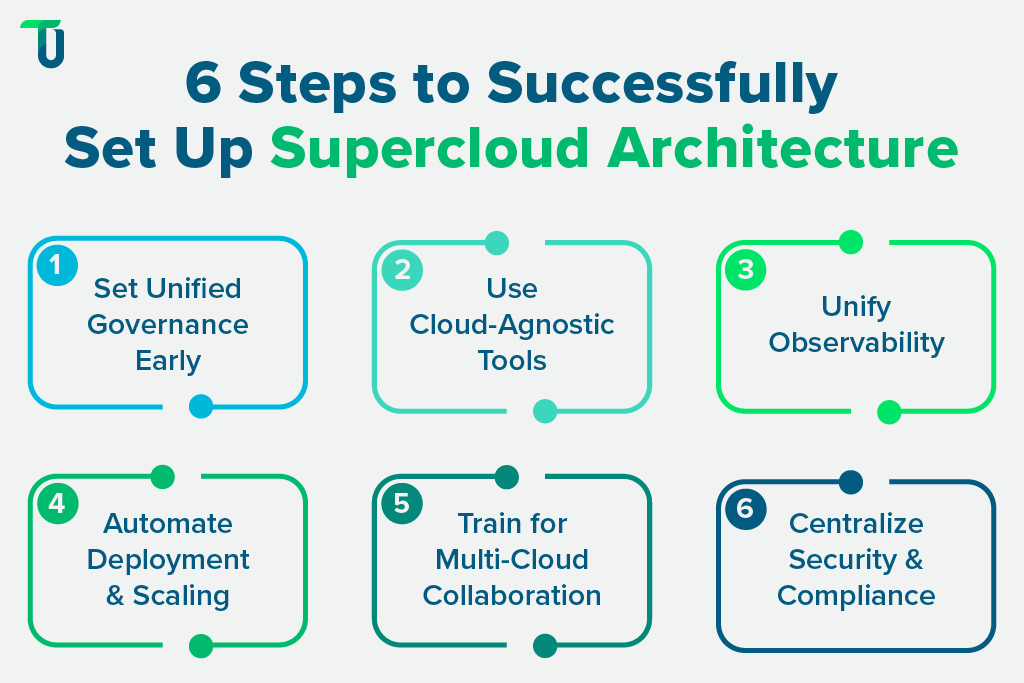
1. Define clear governance and policies before setting up
Start by setting unified rules for security, access, and resource use across all cloud vendors. These policies guide your cloud architecture from day one. Then use centralized tools to enforce them, reducing misconfiguration and ensuring consistent compliance across your entire Supercloud setup.
2. Choose cloud‑agnostic tools and infrastructure standards
Avoid vendor lock‑in by using services built for cross‑cloud use. Tools like Kubernetes multi-cloud deployment, Terraform, or Istio work across providers. This gives flexibility and consistency in your cloud orchestration and cloud integration efforts. It also helps teams manage workloads with familiar environments.
3. Build a unified observability and monitoring strategy
Combine logs, metrics, and traces from all cloud platforms in one place. Use central dashboards to track performance, errors, and usage. This visibility supports quicker troubleshooting and better capacity planning, and is a foundational part of Supercloud-based cloud architecture that keeps infrastructure reliable and cost-efficient.
4. Automate deployment and scaling across clouds
Use automation to deploy apps and scale resources based on demand automatically. Define scripts or pipelines that run on multiple providers. This cloud orchestration approach avoids manual steps, reduces errors, and ensures consistent application performance in any cloud environment.
5. Invest in team expertise and collaborative skills
Train teams in multi‑cloud orchestration, security, and integration best practices. Encourage cross‑team collaboration and knowledge sharing. This helps teams work together, troubleshoot faster, and maintain your Supercloud architecture more confidently over time.
6. Enforce security and compliance with unified tools
Set up centralized identity, encryption, and audit systems across all platforms. Apply the same access rules and monitoring for each environment. This creates a stronger security posture, makes compliance easier to track, and reduces gaps in your cloud architecture.
Following these best practices helps you get the most from Supercloud architecture and for a detailed Supercloud reference architecture blueprint you can explore our in-depth guide for CTOs. With clear governance, the right tools, automation, and team readiness, you can build a flexible, secure, and efficient multi-cloud system.
Final Thoughts: Is Supercloud Architecture Right for You?
f your business uses multiple cloud providers and faces challenges like scattered tools, rising costs, or limited control, learn more about implementing Supercloud in your organization to see practical real-world applications. It brings all your cloud operations under one roof, simplifies cloud integration, improves scalability, and offers centralized visibility across platforms like AWS, Azure, and GCP. For growing teams or enterprises looking to modernize their infrastructure, it adds the flexibility and efficiency needed to scale confidently.
Not sure how to take the next step? Before you begin, review our Supercloud reference architecture blueprint to better understand the full implementation path, then TenUp Software Services can help you execute it.TenUp Software Services is here to help. From planning to execution, we design secure, scalable, and fully tailored Supercloud solutions that perfectly align with your business goals. Explore our comprehensive cloud services and solutions to learn more!
Maximize Efficiency and Cut Costs in Hybrid and Multi-Cloud Setups
Save time, effort, and money with Supercloud solutions. From cloud integration to orchestration, our Cloud experts can handle the complexity for you.
Frequently asked questions
What real-world use cases prove Supercloud Architecture delivers ROI?
Supercloud Architecture cuts cloud costs by up to 40%, as reported by some case studies, and boosts uptime by unifying data and workloads. Use cases include retail data integration, financial compliance automation, and faster AI model training across clouds—all improving agility and reducing complexity.
How does Supercloud Architecture compare to service mesh frameworks like Istio?
Supercloud manages infrastructure, security, and workloads across multiple clouds. Istio handles microservice traffic, security, and observability within a cloud-native app. While Supercloud focuses on cross-cloud orchestration, Istio manages internal service communication. They serve different layers but can work together in modern architecture.
Can small businesses adopt Supercloud, or is it just for enterprises?
Yes, small businesses can adopt a simplified Supercloud using tools like Kubernetes, Terraform, and cross-cloud APIs. It helps them reduce vendor lock-in, boost portability, and scale affordably—without the overhead of enterprise-grade complexity.
How does Supercloud Architecture streamline compliance across multiple clouds?
Supercloud simplifies compliance by enforcing unified security policies, access controls, and audit logs through a centralized control plane. It automates identity, encryption, and monitoring across clouds—making it easier to meet standards like GDPR, HIPAA, and SOC 2 with less manual oversight.
What performance benchmarks (latency, throughput) should I expect from Supercloud?
Supercloud can deliver sub-100ms latency for cross-cloud API calls and 1–10 GBps throughput for distributed workloads, depending on workload type, region proximity, and network optimization. Performance tuning and real-world testing are key to maximizing results. It's worth noting that results may vary depending on distance between regions, workload type, network congestion, and the level of optimization within your organization.
How do you monitor costs and usage across clouds in a Supercloud environment?
Use unified FinOps platforms like CloudHealth or Kubecost integrated into your Supercloud control plane. These tools offer real-time spend tracking, budget alerts, cross-cloud cost allocation, and predictive insights, enabling proactive cost control across AWS, Azure, GCP, and more.
Can Supercloud support edge computing and IoT workloads effectively?
Yes. Supercloud enables real-time edge processing by deploying compute closer to IoT devices, while maintaining centralized control. Its orchestration layer syncs edge and core infrastructure seamlessly—ideal for latency-sensitive, scalable, and hybrid IoT use cases.
What’s the learning curve for DevOps teams adopting Supercloud best practices?
It varies by experience. Teams skilled in multi-cloud, Kubernetes, IaC, and CI/CD adapt faster. Success with Supercloud also requires upskilling in cloud-agnostic tools, unified security policies, and cross-cloud observability.

